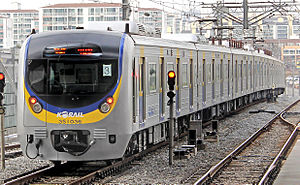
The Suin Line (Suwon-Incheon) was a metro line of the Seoul Metropolitan Subway serving the Seoul Capital Area.

Hyundai Rotem is a South Korean company that manufactures rolling stock, defense products and plant equipment. It is a part of the Hyundai Motor Group. Its name was changed from Rotem to Hyundai Rotem in December 2007 to reflect the parent company.
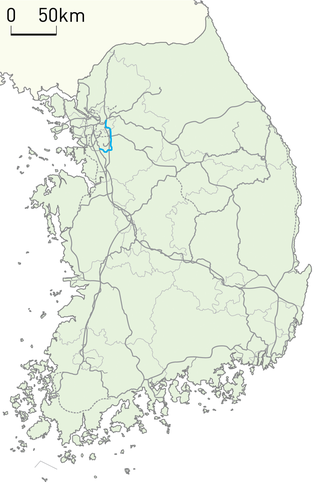
The Bundang Line or Seoul Metropolitan Subway Bundang Line was a commuter rail line of the Seoul Metropolitan Subway in the Seoul Capital Area operated by Korail. Also it refers physical railway track from Wangsimni to Suwon which is designated by MOLIT. The name 'Bundang Line' refers to the fact that the line was originally constructed for the new planned town of Bundang. The line service started in central eastern Seoul at Cheongnyangni, crossing Gangnam District and connecting the cities of Seongnam and Yongin, and terminates at Suwon Station. While the track 'Bundang Line' designated by MOLIT is from Wangsimni to Suwon.
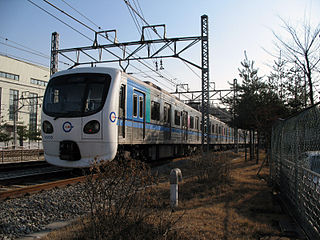
Incheon Subway Line 1 is a 29.4-kilometer (18.3 mi) north-south subway line, part of the Incheon Subway system. The line is also included as a part of the overall Seoul Metropolitan Subway network; Bupyeong Station has a free transfer with Seoul Subway Line 1, Gyeyang Station connects with the AREX Line which leads to Incheon International Airport and Seoul Station, Bupyeong-gu Office Station has a free transfer with Seoul Subway Line 7, and Woninjae Station has a free transfer with the Suin-Bundang Line.
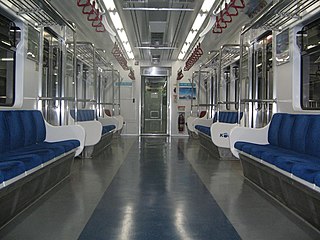
There are many types of trains in Seoul but they are generally similar to each other. All Seoul Metropolitan Subway rolling stock follow the Japanese-style commuter/subway train interior layout of all-longitudinal seating with luggage racks above seats. Typically, train cars have four pairs of doors on each side. In between the doors are rows of either cushioned or non-cushioned seats for 7 people, except for the outer ends of each wagon where there are smaller rows of seats for 3 people, marked for the use by the elderly, disabled passengers, and pregnant women.

The Korail Class 1000 was a series of electric multiple units built in Seoul, South Korea for Seoul Subway Line 1. The cars were built in and entered service between 1974 and 1997. They were gradually retired from the late 1990s to 2020 by newer electric multiple unit trains.

The Korail Class 311000 trains, some train of which were formerly identified as Korail Class 5000 trains, are commuter electric multiple units in South Korea used on Seoul Subway Line 1. Class 311000 trains were manufactured and delivered between 1996 and 2006, and again from 2012 to 2014 to expand service on the Gyeongbu Line and the Gyeongwon Line, and to replace older trains.

Ilsan Line is a subway line operated by Korail, in Seoul, South Korea. Trains from this line continue to and from Seoul Metro's Line 3.

The Seohae Line is a dual-track, electrified rail line in western Gyeonggi-do and Seoul, South Korea. The Seohae Line is being built in four sections simultaneously. The line runs 40.3 km (25.0 mi) south from Daegok in Goyang City, crosses the Han River, passes Gimpo Airport, Sosa, Siheung, and ends in Wonsi in Ansan. There is a transfer to different lines at Daegok, Neunggok, Gimpo Int'l Airport, Bucheon Stadium, Sosa and Choji. There are currently 17 stations (Daegok-Wonsi). The line is operated by Korail, but the stations between Sosa and Wonsi are managed by SEO HAE RAIL CO.,LTD., which is a subsidiary of Seoul Metro. The infrastructure is also owned by Korail so the line runs on the left like the rest of the South Korean mainline railway network.

The KTX-Sancheon is a South Korean high-speed train built by Hyundai Rotem in the second half of the 2000s and operated by Korail since March 2009. With a top speed of 305 km/h (190 mph), the KTX-Sancheon is the second commercial high-speed train operated in South Korea and the first domestic high-speed train that is designed and developed in South Korea.

The Korail Class 321000 trains, created from an assortment of Class 5000, Class 6000, and new cars, are commuter electric multiple units in South Korea used on the Gyeongui-Jungang Line. Class 321000 trains were manufactured and delivered between 2006–2009 to provide service on what was known as the Jungang Line at the time, and to address progressing extensions starting from the extension to Paldang Station.

The Korail Class 331000 trains are commuter electric multiple units in South Korea used on the Gyeongui·Jungang Line. Class 331000 trains were manufactured and delivered in 2009 and from 2012 to 2014 to provide service on the Gyeongui Line and to address progressing extensions starting from the extension to Gongdeok Station.
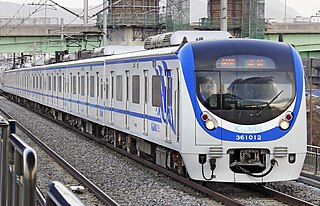
The Korail Class 361000 trains are commuter electric multiple units in South Korea used on the Gyeongchun Line. Class 361000 trains were manufactured and delivered in 2010 to provide service on the Gyeongchun Line.

The Hyundai Rotem EMU is a current model of heavy rail electric multiple units used on the Mass Transit Railway in Hong Kong. The 9-car sets are manufactured by Hyundai Rotem for the North South Corridor, an extension of the East Rail line, at a cost of HK$4 billion. and the first delivery took place in 2015, while a further 6 trains were ordered in May 2020. Originally scheduled to enter service in late-2017 to early-2018, the trains gradually entered service from 6 February 2021. All train sets were put into service in 2022, replacing the Metro Cammell EMUs and displacing the SP1900 EMUs to the Tuen Ma Line.

The Korail Class 371000 trains are commuter electric multiple units in South Korea used on the Gyeonggang Line.

The Korail Class 341000 trains, formerly identified as Korail Class 2000 trains, are commuter electric multiple units in South Korea used on Seoul Subway Line 4. Class 341000 trains were manufactured and delivered between 1993 and 1999 to expand service on the Gwacheon Line and the Ansan Line sections of Line 4.

The LRTA 2000 class, also known by the Light Rail Transit Authority as the Rotem/Toshiba Megatren Model 2003, is a class of electric multiple units of the Light Rail Transit Authority (LRTA) in Metro Manila, Philippines, which began operation in 2003. It is used in Line 2.
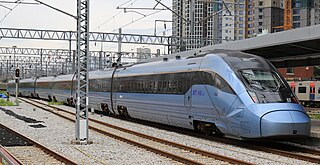
The KTX-Eum or Korail Class 150000 is a South Korean high-speed electric multiple unit train manufactured by Hyundai Rotem and operated by Korail. The word 'eum' in Korean means 'uniting through connection'. This name was selected by members of the public, and expresses the desire to connect regions, people, and happiness through trains.
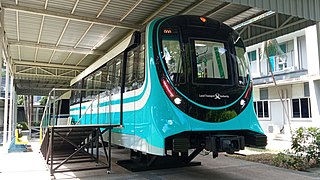
The Hyundai Rotem J151 is the first generation electric multiple unit rolling stock to be introduced on the Jurong Region Line of Singapore's Mass Rapid Transit (MRT) system, manufactured by Hyundai Rotem under Contract J151. 62 three-car medium-capacity Hyundai Rotem trainsets will be delivered from 2024 onwards and service will commence when the line opens in 2027.

The Suin–Bundang Line is a commuter rail service of the Seoul Metropolitan Subway system, operating on trackage from the Suin Line and the Bundang Line. Operation began on September 12, 2020.
